TPMS NISSAN ROGUE SELECT 2015 User Guide
[x] Cancel search | Manufacturer: NISSAN, Model Year: 2015, Model line: ROGUE SELECT, Model: NISSAN ROGUE SELECT 2015Pages: 322, PDF Size: 2.21 MB
Page 220 of 322

failure. Serious vehicle damage
could occur and may lead to an
accident and could result in serious
personal injury. Check the tire pres-
sure for all four tires. Adjust the tire
pressure to the recommended COLD
tire pressure shown on the Tire and
Loading Information label to turn
the low tire pressure warning light
OFF. If you have a flat tire, replace it
with a spare tire as soon as possi-
ble.
. When a spare tire is mounted or a
wheel is replaced, the TPMS will not
function and the low tire pressure
warning light will flash for approxi-
mately 1 minute. The light will
remain on after 1 minute. Contact
your NISSAN dealer as soon as
possible for tire replacement and/
or system resetting.
. Replacing tires with those not ori-
ginally specified by NISSAN could
affect the proper operation of the
TPMS.
. Do not inject any tire liquid or
aerosol tire sealant into the tires,
as this may cause a malfunction of the tire pressure sensors.
CHANGING A FLAT TIRE
If you have a flat tire, follow the instructions
below.
Stopping the vehicle
1. Safely move the vehicle off the road and
away from traffic.
2. Turn on the hazard warning flashers.
3. Park on a level surface and apply the parking brake. Move the shift lever to the P (Park)
position.
4. Turn off the engine.
5. Raise the hood to warn other traffic, and to signal professional road assistance person-
nel that you need assistance.
6. Have all passengers get out of the vehicle and stand in a safe place, away from traffic
and clear of the vehicle.
WARNING
.Make sure the parking brake is
securely applied and the transmis-
sion is shifted into the P (Park)
position. .
Never change tires when the vehicle
is on a slope, ice or slippery areas.
This is hazardous.
. Never change tires if oncoming
traffic is close to your vehicle. Wait
for professional road assistance.
In case of emergency6-3
Page 244 of 322
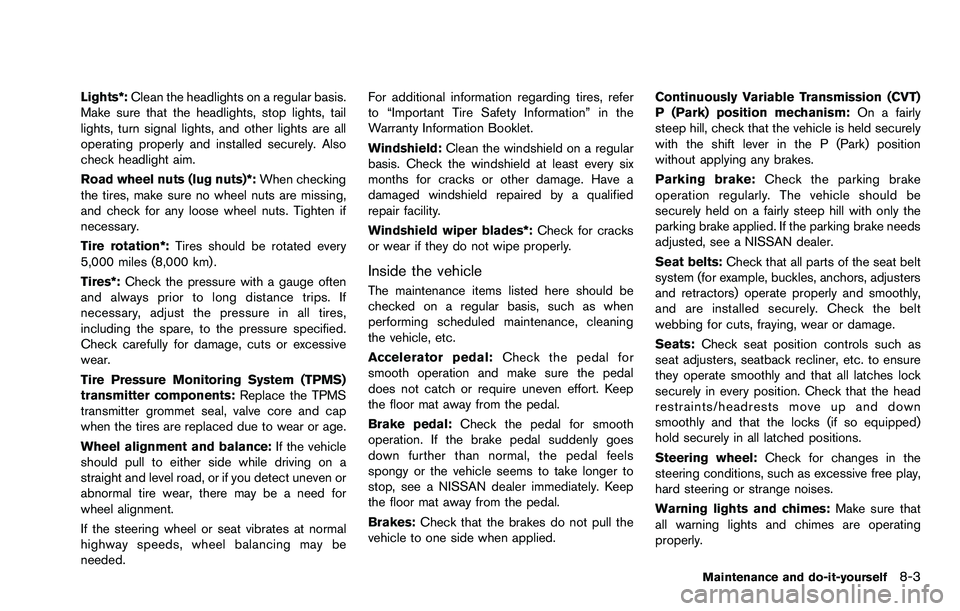
Lights*:Clean the headlights on a regular basis.
Make sure that the headlights, stop lights, tail
lights, turn signal lights, and other lights are all
operating properly and installed securely. Also
check headlight aim.
Road wheel nuts (lug nuts)*: When checking
the tires, make sure no wheel nuts are missing,
and check for any loose wheel nuts. Tighten if
necessary.
Tire rotation*: Tires should be rotated every
5,000 miles (8,000 km) .
Tires*: Check the pressure with a gauge often
and always prior to long distance trips. If
necessary, adjust the pressure in all tires,
including the spare, to the pressure specified.
Check carefully for damage, cuts or excessive
wear.
Tire Pressure Monitoring System (TPMS)
transmitter components: Replace the TPMS
transmitter grommet seal, valve core and cap
when the tires are replaced due to wear or age.
Wheel alignment and balance: If the vehicle
should pull to either side while driving on a
straight and level road, or if you detect uneven or
abnormal tire wear, there may be a need for
wheel alignment.
If the steering wheel or seat vibrates at normal
highway speeds, wheel balancing may be
needed. For additional information regarding tires, refer
to “Important Tire Safety Information” in the
Warranty Information Booklet.
Windshield:
Clean the windshield on a regular
basis. Check the windshield at least every six
months for cracks or other damage. Have a
damaged windshield repaired by a qualified
repair facility.
Windshield wiper blades*: Check for cracks
or wear if they do not wipe properly.
Inside the vehicle
The maintenance items listed here should be
checked on a regular basis, such as when
performing scheduled maintenance, cleaning
the vehicle, etc.
Accelerator pedal: Check the pedal for
smooth operation and make sure the pedal
does not catch or require uneven effort. Keep
the floor mat away from the pedal.
Brake pedal: Check the pedal for smooth
operation. If the brake pedal suddenly goes
down further than normal, the pedal feels
spongy or the vehicle seems to take longer to
stop, see a NISSAN dealer immediately. Keep
the floor mat away from the pedal.
Brakes: Check that the brakes do not pull the
vehicle to one side when applied. Continuously Variable Transmission (CVT)
P (Park) position mechanism:
On a fairly
steep hill, check that the vehicle is held securely
with the shift lever in the P (Park) position
without applying any brakes.
Parking brake: Check the parking brake
operation regularly. The vehicle should be
securely held on a fairly steep hill with only the
parking brake applied. If the parking brake needs
adjusted, see a NISSAN dealer.
Seat belts: Check that all parts of the seat belt
system (for example, buckles, anchors, adjusters
and retractors) operate properly and smoothly,
and are installed securely. Check the belt
webbing for cuts, fraying, wear or damage.
Seats: Check seat position controls such as
seat adjusters, seatback recliner, etc. to ensure
they operate smoothly and that all latches lock
securely in every position. Check that the head
restraints/headrests move up and down
smoothly and that the locks (if so equipped)
hold securely in all latched positions.
Steering wheel: Check for changes in the
steering conditions, such as excessive free play,
hard steering or strange noises.
Warning lights and chimes: Make sure that
all warning lights and chimes are operating
properly.
Maintenance and do-it-yourself8-3
Page 270 of 322
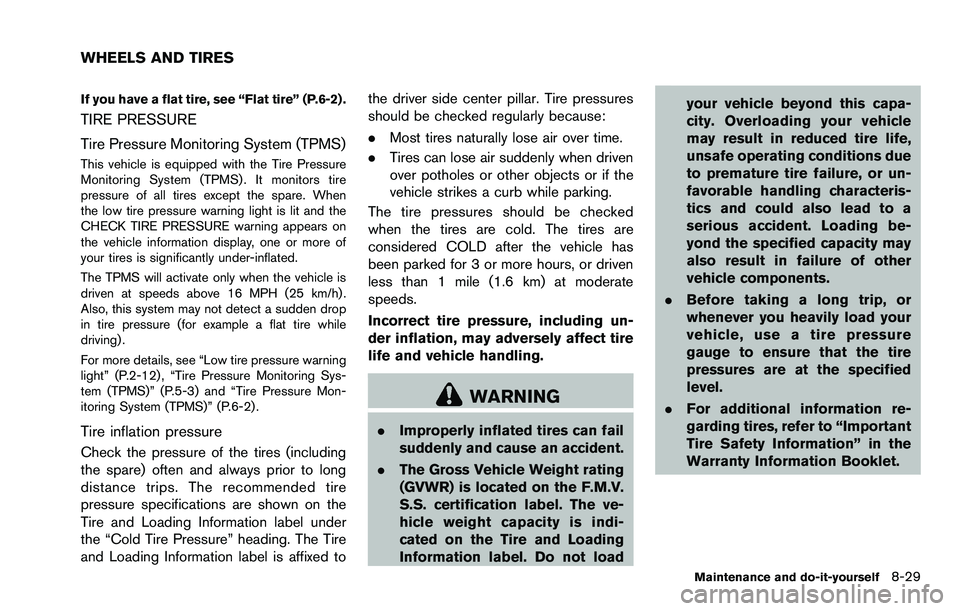
If you have a flat tire, see “Flat tire” (P.6-2) .
TIRE PRESSURE
Tire Pressure Monitoring System (TPMS)
This vehicle is equipped with the Tire Pressure
Monitoring System (TPMS) . It monitors tire
pressure of all tires except the spare. When
the low tire pressure warning light is lit and the
CHECK TIRE PRESSURE warning appears on
the vehicle information display, one or more of
your tires is significantly under-inflated.
The TPMS will activate only when the vehicle is
driven at speeds above 16 MPH (25 km/h) .
Also, this system may not detect a sudden drop
in tire pressure (for example a flat tire while
driving) .
For more details, see “Low tire pressure warning
light” (P.2-12) , “Tire Pressure Monitoring Sys-
tem (TPMS)” (P.5-3) and “Tire Pressure Mon-
itoring System (TPMS)” (P.6-2) .
Tire inflation pressure
Check the pressure of the tires (including
the spare) often and always prior to long
distance trips. The recommended tire
pressure specifications are shown on the
Tire and Loading Information label under
the “Cold Tire Pressure” heading. The Tire
and Loading Information label is affixed tothe driver side center pillar. Tire pressures
should be checked regularly because:
.
Most tires naturally lose air over time.
. Tires can lose air suddenly when driven
over potholes or other objects or if the
vehicle strikes a curb while parking.
The tire pressures should be checked
when the tires are cold. The tires are
considered COLD after the vehicle has
been parked for 3 or more hours, or driven
less than 1 mile (1.6 km) at moderate
speeds.
Incorrect tire pressure, including un-
der inflation, may adversely affect tire
life and vehicle handling.
WARNING
. Improperly inflated tires can fail
suddenly and cause an accident.
. The Gross Vehicle Weight rating
(GVWR) is located on the F.M.V.
S.S. certification label. The ve-
hicle weight capacity is indi-
cated on the Tire and Loading
Information label. Do not load your vehicle beyond this capa-
city. Overloading your vehicle
may result in reduced tire life,
unsafe operating conditions due
to premature tire failure, or un-
favorable handling characteris-
tics and could also lead to a
serious accident. Loading be-
yond the specified capacity may
also result in failure of other
vehicle components.
. Before taking a long trip, or
whenever you heavily load your
vehicle, use a tire pressure
gauge to ensure that the tire
pressures are at the specified
level.
. For additional information re-
garding tires, refer to “Important
Tire Safety Information” in the
Warranty Information Booklet.
Maintenance and do-it-yourself8-29
WHEELS AND TIRES
Page 274 of 322
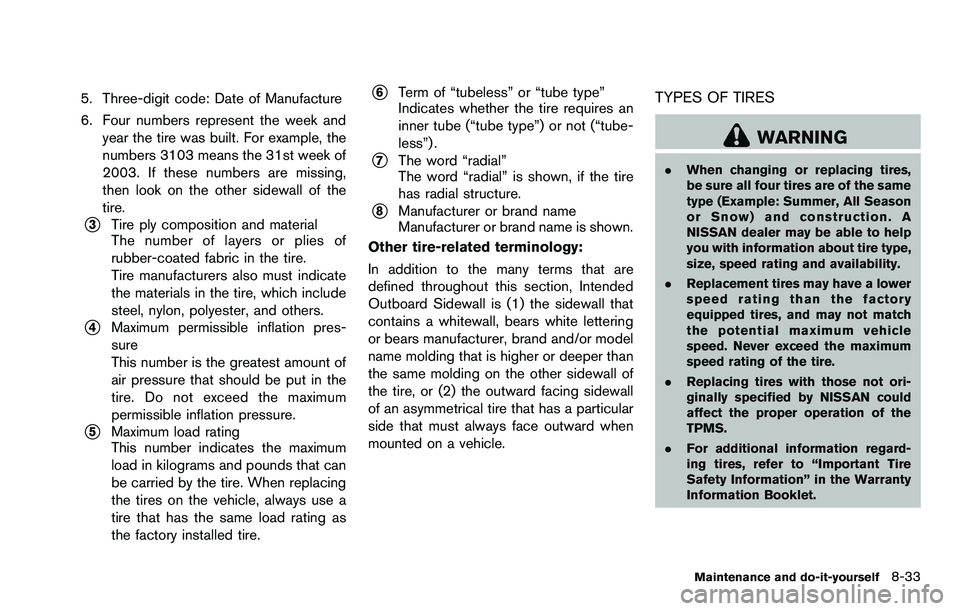
5. Three-digit code: Date of Manufacture
6. Four numbers represent the week andyear the tire was built. For example, the
numbers 3103 means the 31st week of
2003. If these numbers are missing,
then look on the other sidewall of the
tire.
*3Tire ply composition and material
The number of layers or plies of
rubber-coated fabric in the tire.
Tire manufacturers also must indicate
the materials in the tire, which include
steel, nylon, polyester, and others.
*4Maximum permissible inflation pres-
sure
This number is the greatest amount of
air pressure that should be put in the
tire. Do not exceed the maximum
permissible inflation pressure.
*5Maximum load rating
This number indicates the maximum
load in kilograms and pounds that can
be carried by the tire. When replacing
the tires on the vehicle, always use a
tire that has the same load rating as
the factory installed tire.
*6Term of “tubeless” or “tube type”
Indicates whether the tire requires an
inner tube (“tube type”) or not (“tube-
less”) .
*7The word “radial”
The word “radial” is shown, if the tire
has radial structure.
*8Manufacturer or brand name
Manufacturer or brand name is shown.
Other tire-related terminology:
In addition to the many terms that are
defined throughout this section, Intended
Outboard Sidewall is (1) the sidewall that
contains a whitewall, bears white lettering
or bears manufacturer, brand and/or model
name molding that is higher or deeper than
the same molding on the other sidewall of
the tire, or (2) the outward facing sidewall
of an asymmetrical tire that has a particular
side that must always face outward when
mounted on a vehicle.
TYPES OF TIRES
WARNING
. When changing or replacing tires,
be sure all four tires are of the same
type (Example: Summer, All Season
or Snow) and construction. A
NISSAN dealer may be able to help
you with information about tire type,
size, speed rating and availability.
. Replacement tires may have a lower
speed rating than the factory
equipped tires, and may not match
the potential maximum vehicle
speed. Never exceed the maximum
speed rating of the tire.
. Replacing tires with those not ori-
ginally specified by NISSAN could
affect the proper operation of the
TPMS.
. For additional information regard-
ing tires, refer to “Important Tire
Safety Information” in the Warranty
Information Booklet.
Maintenance and do-it-yourself8-33
Page 278 of 322

Replacing wheels and tires
When replacing a tire, use the same size, tread
design, speed rating and load carrying capacity
as originally equipped. (See “Specifications”
(P.9-7) for recommended types and sizes of
tires and wheels.)
WARNING
.The use of tires other than those
recommended or the mixed use of
tires of different brands, construc-
tion (bias, bias-belted or radial) , or
tread patterns can adversely affect
the ride, braking, handling, ground
clearance, body-to-tire clearance,
tire chain clearance, speedometer
calibration, headlight aim and bum-
per height. Some of these effects
may lead to accidents and could
result in serious personal injury.
. For 2WD models, if your vehicle was
originally equipped with 4 tires that
were the same size and you are only
replacing 2 of the 4 tires, install the
new tires on the rear axle. Placing
new tires on the front axle may
cause loss of vehicle control in
some driving conditions and cause an accident and personal injury.
. If the wheels are changed for any
reason, always replace with wheels
which have the same off-set dimen-
sion. Wheels of a different off-set
could cause premature tire wear,
degrade vehicle handling character-
istics and/or interference with the
brake discs/drums. Such interfer-
ence can lead to decreased braking
efficiency and/or early brake pad/
shoe wear. See “Wheels and tires”
(P.9-7) of this manual for wheel off-
set dimensions.
. When a spare tire is mounted or a
wheel is replaced, the TPMS will not
function and the low tire pressure
warning light will flash for approxi-
mately 1 minute. The light will
remain on after 1 minute. Contact
your NISSAN dealer as soon as
possible for tire replacement and/
or system resetting.
. Replacing tires with those not ori-
ginally specified by NISSAN could
affect the proper operation of the
TPMS.
. Do not install a damaged or de-
formed wheel or tire even if it has been repaired. Such wheels or tires
could have structural damage and
could fail without warning.
. The use of retread tire is not re-
commended.
. For additional information regard-
ing tires, refer to “Important Tire
Safety Information” in the Warranty
Information Booklet.
CAUTION
Always use tires of the same type, size,
brand, construction (bias, bias-belted
or radial) , and tread pattern on all four
wheels. Failure to do so may result in a
circumference difference between tires
on the front and rear axles which will
cause excessive tire wear and may
damage the transmission, transfer case
and differential gears (AWD models) .
Maintenance and do-it-yourself8-37
Page 279 of 322
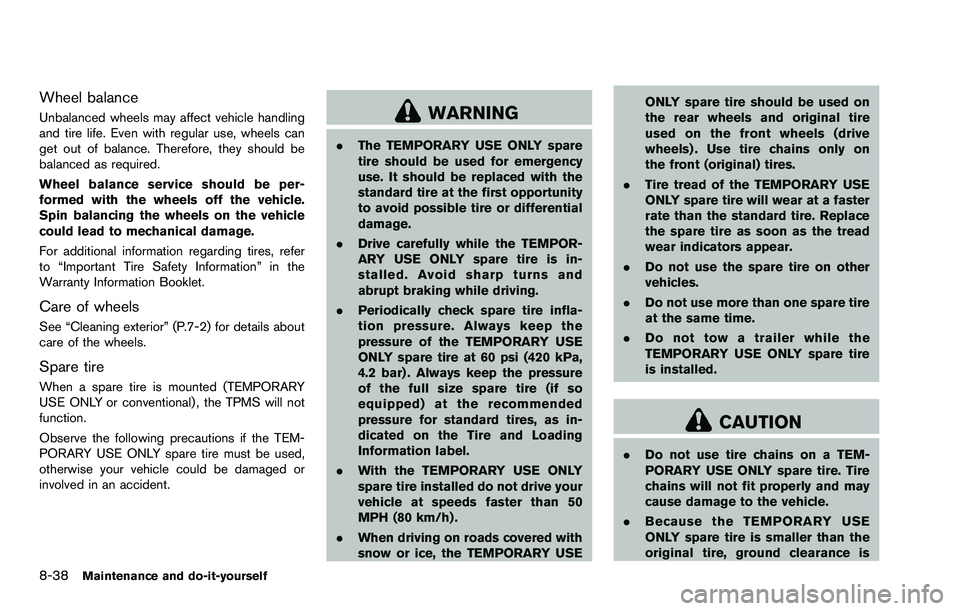
8-38Maintenance and do-it-yourself
Wheel balance
Unbalanced wheels may affect vehicle handling
and tire life. Even with regular use, wheels can
get out of balance. Therefore, they should be
balanced as required.
Wheel balance service should be per-
formed with the wheels off the vehicle.
Spin balancing the wheels on the vehicle
could lead to mechanical damage.
For additional information regarding tires, refer
to “Important Tire Safety Information” in the
Warranty Information Booklet.
Care of wheels
See “Cleaning exterior” (P.7-2) for details about
care of the wheels.
Spare tire
When a spare tire is mounted (TEMPORARY
USE ONLY or conventional) , the TPMS will not
function.
Observe the following precautions if the TEM-
PORARY USE ONLY spare tire must be used,
otherwise your vehicle could be damaged or
involved in an accident.
WARNING
.The TEMPORARY USE ONLY spare
tire should be used for emergency
use. It should be replaced with the
standard tire at the first opportunity
to avoid possible tire or differential
damage.
. Drive carefully while the TEMPOR-
ARY USE ONLY spare tire is in-
stalled. Avoid sharp turns and
abrupt braking while driving.
. Periodically check spare tire infla-
tion pressure. Always keep the
pressure of the TEMPORARY USE
ONLY spare tire at 60 psi (420 kPa,
4.2 bar) . Always keep the pressure
of the full size spare tire (if so
equipped) at the recommended
pressure for standard tires, as in-
dicated on the Tire and Loading
Information label.
. With the TEMPORARY USE ONLY
spare tire installed do not drive your
vehicle at speeds faster than 50
MPH (80 km/h) .
. When driving on roads covered with
snow or ice, the TEMPORARY USE ONLY spare tire should be used on
the rear wheels and original tire
used on the front wheels (drive
wheels) . Use tire chains only on
the front (original) tires.
. Tire tread of the TEMPORARY USE
ONLY spare tire will wear at a faster
rate than the standard tire. Replace
the spare tire as soon as the tread
wear indicators appear.
. Do not use the spare tire on other
vehicles.
. Do not use more than one spare tire
at the same time.
. Do not tow a trailer while the
TEMPORARY USE ONLY spare tire
is installed.
CAUTION
.Do not use tire chains on a TEM-
PORARY USE ONLY spare tire. Tire
chains will not fit properly and may
cause damage to the vehicle.
. Because the TEMPORARY USE
ONLY spare tire is smaller than the
original tire, ground clearance is
Page 314 of 322
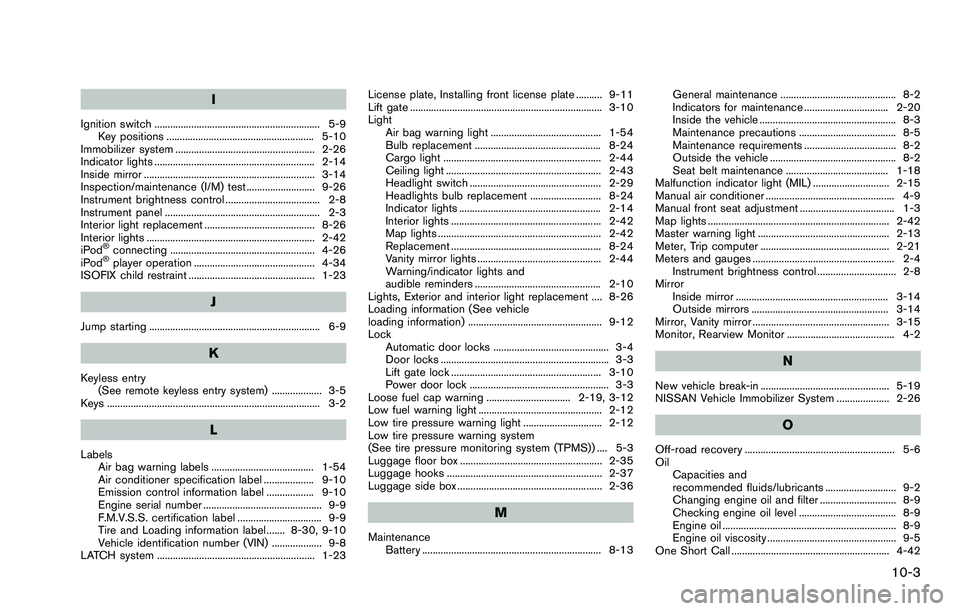
I
Ignition switch ............................................................... 5-9Key positions ........................................................ 5-10
Immobilizer system ..................................................... 2-26
Indicator lights ............................................................. 2-14
Inside mirror ................................................................. 3-14
Inspection/maintenance (I/M) test .......................... 9-26
Instrument brightness control .................................... 2-8
Instrument panel ........................................................... 2-3
Interior light replacement .......................................... 8-26
Interior lights ................................................................ 2-42
iPod
�Šconnecting ....................................................... 4-26
iPod�Šplayer operation .............................................. 4-34
ISOFIX child restraint ................................................ 1-23
J
Jump starting ................................................................. 6-9
K
Keyless entry (See remote keyless entry system) ................... 3-5
Keys ................................................................................. 3-2
L
Labels Air bag warning labels ....................................... 1-54
Air conditioner specification label ................... 9-10
Emission control information label .................. 9-10
Engine serial number ............................................. 9-9
F.M.V.S.S. certification label ................................ 9-9
Tire and Loading information label ....... 8-30, 9-10
Vehicle identification number (VIN) ................... 9-8
LATCH system ............................................................ 1-23 License plate, Installing front license plate .......... 9-11
Lift gate ......................................................................... 3-10
Light
Air bag warning light .......................................... 1-54
Bulb replacement ................................................ 8-24
Cargo light ............................................................ 2-44
Ceiling light ........................................................... 2-43
Headlight switch .................................................. 2-29
Headlights bulb replacement ........................... 8-24
Indicator lights ...................................................... 2-14
Interior lights ......................................................... 2-42
Map lights .............................................................. 2-42
Replacement ......................................................... 8-24
Vanity mirror lights ............................................... 2-44
Warning/indicator lights and
audible reminders ................................................ 2-10
Lights, Exterior and interior light replacement .... 8-26
Loading information (See vehicle
loading information) ................................................... 9-12
Lock
Automatic door locks ............................................ 3-4
Door locks ................................................................ 3-3
Lift gate lock ......................................................... 3-10
Power door lock ..................................................... 3-3
Loose fuel cap warning ................................ 2-19, 3-12
Low fuel warning light ............................................... 2-12
Low tire pressure warning light .............................. 2-12
Low tire pressure warning system
(See tire pressure monitoring system (TPMS)) .... 5-3
Luggage floor box ...................................................... 2-35
Luggage hooks ........................................................... 2-37
Luggage side box ....................................................... 2-36
M
Maintenance Battery .................................................................... 8-13 General maintenance ............................................ 8-2
Indicators for maintenance ................................ 2-20
Inside the vehicle .................................................... 8-3
Maintenance precautions ..................................... 8-5
Maintenance requirements ................................... 8-2
Outside the vehicle ................................................ 8-2
Seat belt maintenance ....................................... 1-18
Malfunction indicator light (MIL) ............................. 2-15
Manual air conditioner ................................................. 4-9
Manual front seat adjustment .................................... 1-3
Map lights ..................................................................... 2-42
Master warning light .................................................. 2-13
Meter, Trip computer ................................................. 2-21
Meters and gauges ...................................................... 2-4 Instrument brightness control .............................. 2-8
Mirror Inside mirror .......................................................... 3-14
Outside mirrors .................................................... 3-14
Mirror, Vanity mirror .................................................... 3-15
Monitor, Rearview Monitor ......................................... 4-2
N
New vehicle break-in ................................................. 5-19
NISSAN Vehicle Immobilizer System .................... 2-26
O
Off-road recovery ......................................................... 5-6
Oil Capacities and
recommended fluids/lubricants ........................... 9-2
Changing engine oil and filter ............................. 8-9
Checking engine oil level ..................................... 8-9
Engine oil .................................................................. 8-9
Engine oil viscosity ................................................. 9-5
One Short Call ............................................................ 4-42
10-3
Page 316 of 322

Starting the engine ............................................. 5-11
Status light, Front passenger air bag .................... 1-48
Steering Electric power steering system ....................... 5-24
Steering wheel switch for audio controls ..... 4-37
Tilting steering wheel ......................................... 3-13
Storage ......................................................................... 2-32
Sun visors ..................................................................... 3-13
Sunglasses holder ...................................................... 2-33
Supplemental air bag warning labels .................... 1-54
Supplemental air bag warning light ........... 1-54, 2-14
Supplemental restraint system ................................ 1-41 Precautions on supplemental
restraint system .................................................... 1-41
Switch All-Wheel Drive (AWD) lock switch ............... 5-21
Audio control steering wheel switch .............. 4-37
Hazard warning flasher switch ............................ 6-2
Headlight switch .................................................. 2-29
Ignition switch ......................................................... 5-9
Overdrive OFF switch ........................................ 5-15
Power door lock switch ........................................ 3-4
Rear window defroster switch ......................... 2-29
Sport mode switch .............................................. 5-14
Turn signal switch ................................................ 2-30
Vehicle dynamic control (VDC) off switch .... 2-31
T
Tachometer ..................................................................... 2-6
Temperature gauge, Engine coolant
temperature gauge ....................................................... 2-6
Theft (NISSAN Vehicle Immobilizer System) ,
Engine start .................................................................. 2-26
Three-way catalyst ....................................................... 5-3
Tilting steering wheel ................................................ 3-13
Tire pressure, Low tire pressure warning light .... 2-12 Tires
Flat tire ...................................................................... 6-2
Low tire pressure warning system ..................... 5-3
Tire and Loading information label ....... 8-30, 9-10
Tire chains ............................................................. 8-34
Tire dressing ............................................................ 7-4
Tire pressure ......................................................... 8-29
Tire pressure monitoring
system (TPMS) .............................................. 5-3, 6-2
Tire rotation ........................................................... 8-35
Types of tires ........................................................ 8-33
Uniform tire quality grading ............................... 9-25
Wheel/tire size ........................................................ 9-7
Wheels and tires ................................................. 8-29
Tonneau cover (see cargo cover) .......................... 2-36
Towing Flat towing ............................................................. 9-24
Tow truck towing ................................................. 6-12
Towing safety ........................................................ 9-20
Trailer towing ........................................................ 9-16
TPMS, Tire pressure monitoring system ................ 5-3
TPMS, Tire pressure warning system ..................... 6-2
Trailer towing ............................................................... 9-16
Transmission Continuously Variable Transmission
(CVT) fluid ............................................................. 8-11
Driving with CVT (Continuously
Variable Transmission) .............................. 5-9, 5-12
Transmission shift lever lock release .............. 5-16
Transmitter (See remote keyless entry system) .... 3-5
Traveling or registering your vehicle in
another country ............................................................. 9-8
Trip computer .............................................................. 2-21
Turn signal switch ....................................................... 2-30
U
Underbody cleaning ..................................................... 7-3
Uniform tire quality grading ...................................... 9-25
USB (Universal Serial Bus) connection port ....... 4-33
Utility hook .................................................................... 2-38
V
Vanity mirror ................................................................. 3-15
Vanity mirror lights ...................................................... 2-44
Vehicle Dimensions and weights ...................................... 9-8
Identification number (VIN) .................................. 9-8
Information display............................................... 2-17
Loading information ............................................ 9-12
Recovery (freeing a stuck vehicle) .................. 6-14
Security system .................................................... 2-24
Vehicle dynamic control (VDC) off switch .... 2-31
Vehicle dynamic control (VDC) system ......... 5-27
Vehicle dynamic control (VDC) warning light ..... 2-14
Ventilators ....................................................................... 4-7
Voice command (Bluetooth
�ŠHands-Free
Phone System) ........................................................... 4-45
Voice Prompt Interrupt .............................................. 4-42
W
Warning Hazard warning flasher switch ............................ 6-2
Lights ...................................................................... 2-10
Tire pressure monitoring
system (TPMS) .............................................. 5-3, 6-2
Warning/indicator lights and
audible reminders ................................................... 2-9
Warning labels, Air bag warning labels ................ 1-54
10-5